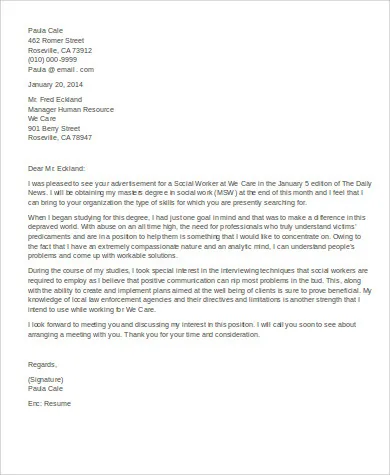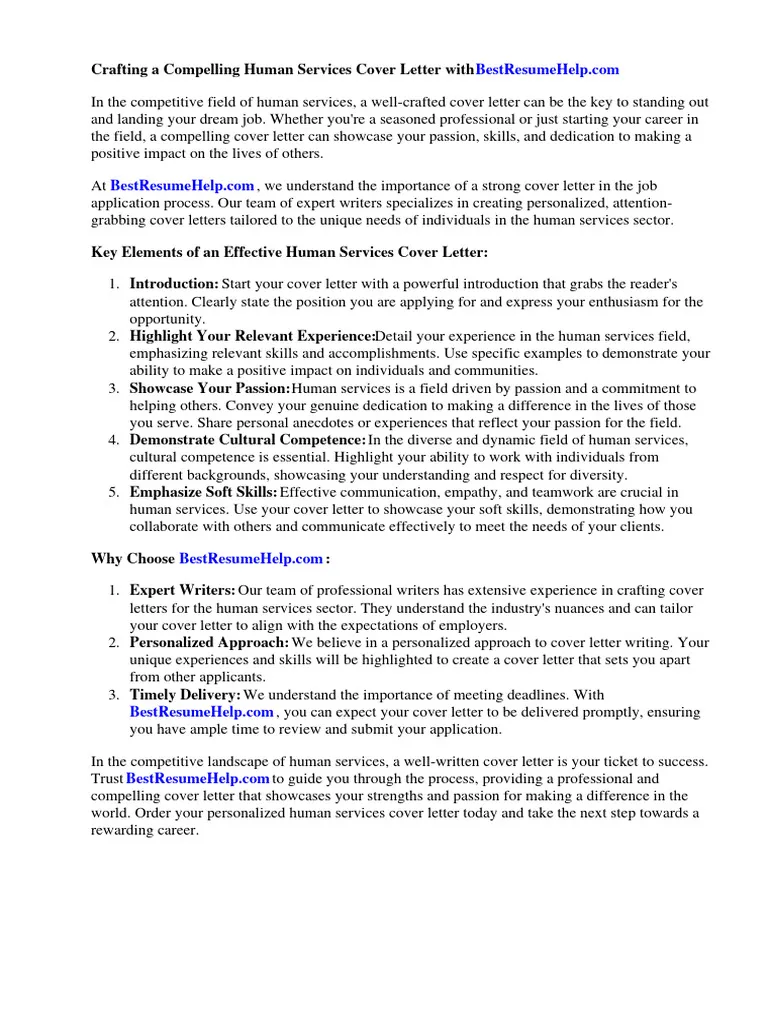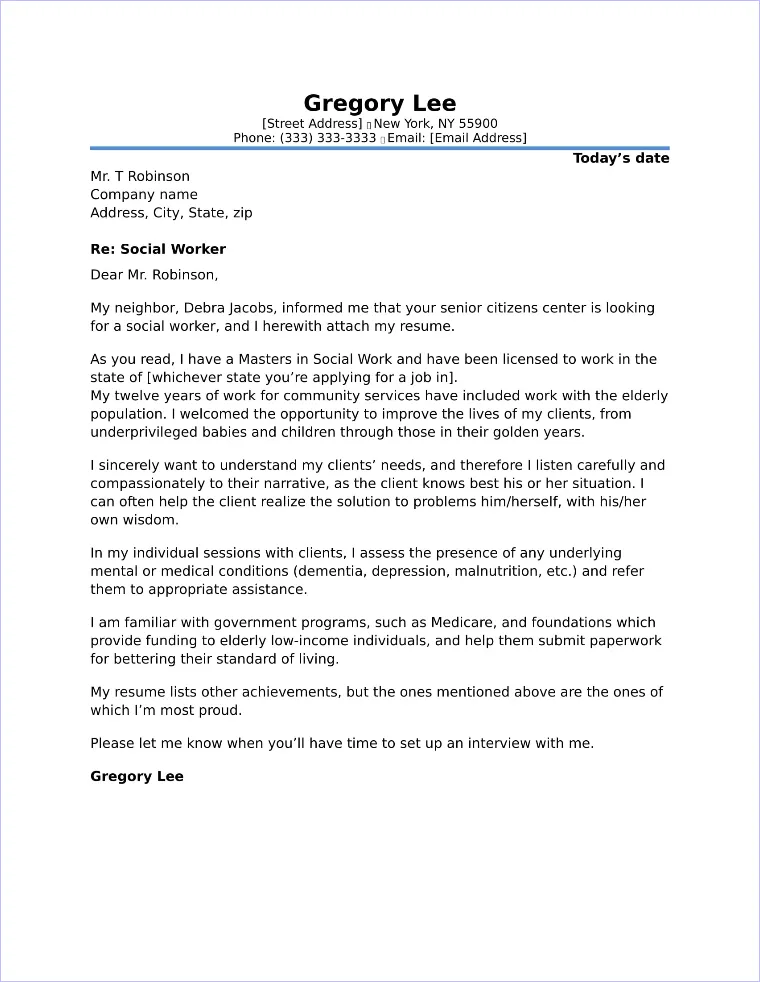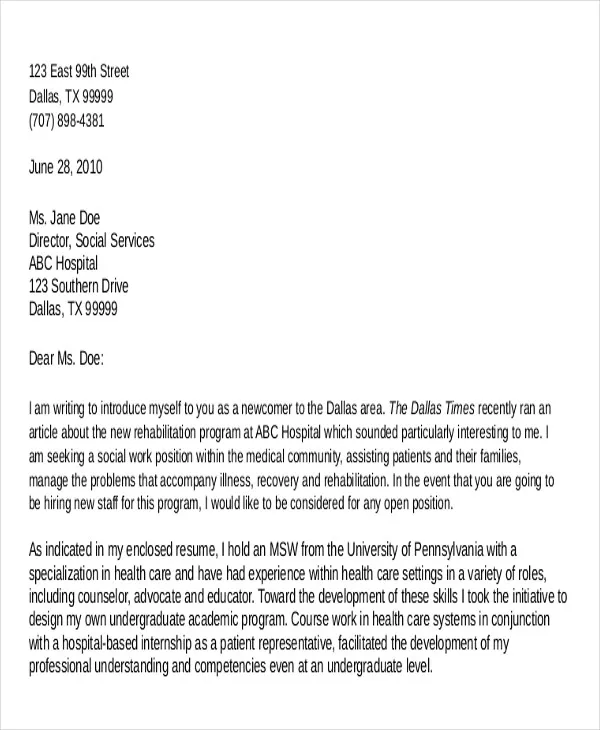Understanding Human Services Cover Letters
In the competitive field of human services, a well-crafted cover letter is your first chance to make a lasting impression on potential employers. It’s more than just a formality; it’s a crucial tool that allows you to introduce yourself, showcase your skills and experience, and express your genuine passion for helping others. Human services cover letters provide a unique opportunity to personalize your application and demonstrate why you’re the perfect fit for the role. They bridge the gap between your resume’s static information and the dynamic individual behind it, giving hiring managers insight into your personality, motivations, and suitability for the position.
The Importance of a Strong Cover Letter
A strong cover letter is essential because it significantly increases your chances of securing an interview. It sets the tone for your application, providing a clear and concise overview of your qualifications and aspirations. By highlighting your relevant skills, experience, and personal qualities, you can capture the attention of hiring managers and convince them to delve deeper into your resume. Moreover, a well-written cover letter showcases your communication skills, which are paramount in the human services field. It demonstrates your ability to articulate your thoughts effectively and convey your passion for the work, setting you apart from other applicants.
Key Components of a Human Services Cover Letter

Your human services cover letter should include several key components to effectively communicate your qualifications and enthusiasm. Start with a professional header that includes your contact information and the date. Address the letter to the hiring manager, if possible, to demonstrate your attention to detail and genuine interest in the position. The opening paragraph should capture the reader’s attention, state the position you’re applying for, and briefly explain why you’re a strong candidate. The body of the letter is where you showcase your skills, experience, and accomplishments, providing specific examples to support your claims. Conclude by expressing your interest in an interview and thanking the employer for their time and consideration.
Top 5 Tips for Writing a Stellar Cover Letter
Crafting a stellar cover letter can significantly improve your chances of landing your dream job in human services. Focus on these top five tips to create a compelling and effective cover letter that showcases your skills and passion. Each tip is designed to help you create a cover letter that resonates with hiring managers and makes you stand out from the competition. By incorporating these strategies, you can transform your cover letter from a generic document into a powerful tool that gets you noticed and sets the stage for a successful interview.
Highlighting Relevant Skills and Experience
Emphasize the skills and experiences most relevant to the human services role. Review the job description carefully and identify the key requirements. Then, showcase how your past experiences and qualifications align with these needs. Provide specific examples of how you’ve demonstrated those skills in previous roles, using concrete details to support your claims. Mention any relevant certifications, training programs, or volunteer work that have prepared you for the position. By highlighting your relevant skills, you demonstrate your immediate ability to contribute to the organization and succeed in the role.
Quantifying Accomplishments and Results

Instead of simply listing your responsibilities, quantify your accomplishments to make your impact more tangible. Use numbers, statistics, and data to demonstrate the results you’ve achieved in previous roles. For example, if you increased client engagement in a program, provide the percentage increase or the specific number of clients who benefited. If you implemented a new process that improved efficiency, mention the time saved or the cost reduction. Quantifying your accomplishments adds credibility to your claims and gives the hiring manager a clear understanding of your value and potential contributions.
Tailoring Your Cover Letter to Each Job
Avoid using a generic cover letter for every job application. Tailor each letter to the specific position and organization you’re applying to. Research the organization’s mission, values, and programs to understand their needs and priorities. Then, customize your letter to reflect how your skills and experience align with their specific requirements. Mention the organization’s name and the specific position you’re applying for to show that you’ve taken the time to understand their needs. Tailoring your cover letter demonstrates your genuine interest in the role and makes you more likely to stand out from the crowd.
Showcasing Your Passion for Human Services
Express your passion for human services throughout your cover letter. Share why you’re drawn to this field and what motivates you to help others. Explain how your personal experiences and values align with the organization’s mission. Mention any specific programs or initiatives that resonate with you, demonstrating your understanding and interest. By showcasing your passion, you demonstrate your commitment to the work and your ability to connect with clients and colleagues. Let your enthusiasm shine through, making your cover letter memorable and compelling to the hiring manager.
Using Action Verbs and Strong Language

Use action verbs and strong language to make your cover letter more dynamic and engaging. Instead of stating your responsibilities passively, describe what you did using powerful verbs that convey your skills and achievements. For example, use words like ‘managed,’ ‘developed,’ ‘implemented,’ ‘coordinated,’ and ‘achieved.’ Avoid generic phrases and clichés, and replace them with concise, impactful statements. By using strong language, you can create a cover letter that captures the reader’s attention and conveys your confidence and expertise. A well-written cover letter demonstrates your ability to communicate effectively and make a positive impact.
Cover Letter Examples for Human Services
Reviewing cover letter examples is a great way to understand the best practices and tailor your own letter. Here are three examples tailored to different experience levels and positions within human services. Each example is designed to give you inspiration and demonstrate how to effectively showcase your skills and experience.
Example 1 Recent Graduate
For recent graduates, the cover letter is a chance to highlight relevant coursework, internships, and volunteer experiences. Focus on transferable skills like communication, empathy, and problem-solving. Quantify accomplishments whenever possible, such as the number of clients you assisted or the positive feedback you received from supervisors. Tailor your letter to the specific requirements of the job, emphasizing how your education and experiences align with the organization’s mission. This should showcase your eagerness to learn and willingness to contribute to the team.
Example 2 Experienced Social Worker

Experienced social workers should focus on their track record of success and their leadership abilities. Highlight your key accomplishments, such as successful case management outcomes, program development, or staff training. Showcase your ability to work with diverse populations and your commitment to ethical practice. Quantify your accomplishments whenever possible, using data to demonstrate your positive impact on clients and the organization. Provide examples of your leadership skills and your ability to collaborate with other professionals. The letter must reflect your depth of expertise and your dedication to the field.
Example 3 Case Manager
Case managers should emphasize their skills in assessment, advocacy, and service coordination. Highlight your experience in developing and implementing individualized service plans, ensuring client access to resources, and maintaining accurate documentation. Provide specific examples of how you’ve effectively managed a caseload, resolved client issues, and collaborated with community partners. Showcase your empathy, communication skills, and ability to advocate for clients’ needs. Quantify your achievements by mentioning the number of clients you’ve served, the positive outcomes achieved, or the improvements in client well-being.
Formatting Your Cover Letter
The format of your cover letter is important because it can influence the reader’s first impression. A well-formatted cover letter is easy to read and presents your information in a clear and organized manner. Proper formatting demonstrates your attention to detail and your professionalism, making you more likely to be considered for the position.
Choosing the Right Font and Format

Select a professional and easy-to-read font, such as Times New Roman, Arial, or Calibri. Use a font size between 10 and 12 points for the body text and 12 to 14 points for headings. Maintain consistent formatting throughout the document, using clear headings and subheadings to organize the content. Use standard business letter format, with your contact information, the date, the hiring manager’s information, and a formal closing. Ensure that your letter has ample white space, including margins of at least one inch on all sides. This improves readability and creates a clean, professional appearance. The cover letter must look easy to read and follow.
Proofreading and Editing Your Cover Letter
Proofreading and editing are essential steps in ensuring your cover letter is free of errors and presents you in the best possible light. Carefully review your letter for any grammatical errors, spelling mistakes, and typos. Check for clarity and conciseness, ensuring that your message is clear and easy to understand. Ask a friend, family member, or career counselor to review your letter for a fresh perspective and to catch any errors you might have missed. The quality of your cover letter reflects your attention to detail and professionalism, so take the time to polish your work. Make sure your language is perfect to represent yourself in a positive way.
Conclusion Crafting a Winning Cover Letter
A well-crafted cover letter is a powerful tool for securing a job in human services. By understanding the key components, following the tips, and reviewing the examples, you can create a cover letter that stands out from the competition. Remember to highlight your relevant skills, quantify your accomplishments, tailor your letter to each job, showcase your passion, and use strong language. Format your letter professionally and proofread it carefully. With a compelling cover letter, you’ll be well on your way to landing your dream job and making a positive impact on the lives of others. Invest time in crafting a great cover letter, and it will pay off.
